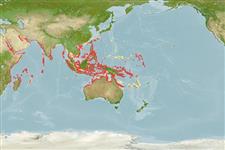>
Gobiiformes (Gobies) >
Gobiidae (Gobies) > Gobiinae
Eponymy: Dr Frederik Petrus Koumans (1905–1977) was a Dutch ichthyologist who was Curator of Fishes at Rijksmuseum van Natuurlijke Historie (Leiden, Netherlands). [...] Gordon Hector (1918–2001) was Chief Secretary to the Government of the Seychelles, in which capacity he was honoured for his ‘great assistance’ to Smith’s work about the archipelago. [...] (Ref. 128868), visit book page.
More on author: Smith.
Environment: milieu / climate zone / depth range / distribution range
Écologie
marin récifal; profondeur 3 - 30 m (Ref. 90102), usually 5 - 20 m (Ref. 27115). Tropical; 22°C - 30°C (Ref. 27115); 30°N - 22°S, 32°E - 175°E
Indo-West Pacific: from Seychelles to Fiji; north to Japan, south to New Caledonia.
Taille / Poids / Âge
Maturity: Lm ? range ? - ? cm
Max length : 8.5 cm SL mâle / non sexé; (Ref. 48637)
Description synthétique
Clés d'identification | Morphologie | Morphométrie
Épines dorsales (Total) : 7; Rayons mous dorsaux (Total) : 15 - 17; Épines anales: 1; Rayons mous anaux: 15 - 16. This species is distinguished by the following characters: D VI + I,15-17; A I,15-16; pectoral-fin rays 16-17; scales in longitudinal series 49-54, in transverse series 17-18; interorbital wide, 67-90 % of eye diameter; rear margin of upper jaw ending posteriorly slightly behind or at vertical through anterior margin of eye; first two dorsal-fin spines filiform, elongate, remaining progressively shorter, the sixth dorsal-fin spine almost reaches the origin of the second dorsal; small ctenoid scales on body, cycloid at axil of pectoral fin, nape and entire belly, and in the area between first dorsal fin and pectoral fin; predorsal scales 16-22, scales not reaching to the vertical through the posterior edge of eye, ending at the level of pore G or H'; cheek and opercle naked; scales cover the basal 1/3-1/4 of caudal fin, becoming rapidly smaller and cycloid; prepectoral area with about 4-9 vertical series of fine cycloid scales covering the entire base of the pectoral fin; prepelvic area with cycloid scales, 9-14 in the midventral row; width at anal-fin origin 9.9-10.7% of SL; caudal peduncle depth 75.4-88.9% of its length; head depth 47.3-54.4% of HL; length of 11th second dorsal-fin ray 11.8-14.2% of SL; length of 8th anal-fin ray 13.7-14.9% of SL (Ref. 119548).
Inhabits sheltered bays and inner reefs on fine rubble shaded by large living corals (Ref. 48637). Occurs solitarily, hovering a short distance above sandy bottoms of reef bases. Stomach contents of one specimen comprise of filamentous algae, harpacticoid copepods, ostracods, amphipods, and nematodes (Ref. 9360).
Life cycle and mating behavior
Maturité | Reproduction | Frai | Œufs | Fécondité | Larves
Kovačić, M., S.V. Bogorodsky, A.O. Mal and T.J. Alpermann, 2018. Redescription of the genus Koumansetta (Teleostei: Gobiidae), with description of a new species from the Red Sea. Zootaxa 4459(3):453-481. (Ref. 119548)
Statut dans la liste rouge de l'IUCN (Ref. 130435: Version 2024-2)
Menace pour l'homme
Harmless
Utilisations par l'homme
Pêcheries: commercial; Aquarium: Commercial
Outils
Articles particuliers
Télécharger en XML
Sources Internet
Estimates based on models
Preferred temperature (Ref.
123201): 24.7 - 29.2, mean 28.4 °C (based on 320 cells).
Phylogenetic diversity index (Ref.
82804): PD
50 = 0.6250 [Uniqueness, from 0.5 = low to 2.0 = high].
Bayesian length-weight: a=0.00724 (0.00339 - 0.01546), b=3.10 (2.92 - 3.28), in cm total length, based on LWR estimates for this (Sub)family-body shape (Ref.
93245).
Niveau trophique (Ref.
69278): 2.1 ±0.1 se; based on diet studies.
Résilience (Ref.
120179): Haut, temps minimum de doublement de population inférieur à 15 mois (Preliminary K or Fecundity.).
Fishing Vulnerability (Ref.
59153): Low vulnerability (10 of 100).
Nutrients (Ref.
124155): Calcium = 162 [70, 326] mg/100g; Iron = 0.867 [0.407, 1.738] mg/100g; Protein = 17.4 [15.4, 19.2] %; Omega3 = 0.0835 [, ] g/100g; Selenium = 26 [12, 64] μg/100g; VitaminA = 114 [24, 529] μg/100g; Zinc = 2.67 [1.65, 4.09] mg/100g (wet weight);
